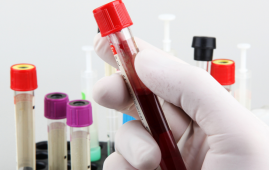

An international research consortium led by LMU tested a new quick analytical equipment that just requires a blood sample from the fingertip for tuberculosis diagnosis.
Every year, over 240,000 children worldwide die from TB. The disease is one among the top ten killers of children under the age of five. One of the main reasons for increased mortality is that tuberculosis is frequently misdiagnosed or not detected in time, especially in resource-limited areas. A new diagnostic tool, tested as part of a large-scale study in five countries by an international research consortium led by LMU medical scientists Laura Olbrich and Norbert Heinrich from the Division of Infectious Diseases and Tropical Medicine at LMU University Hospital Munich, represents significant progress in this area contributing to tuberculosis diagmosis. The authors report on their findings in The Lancet Infectious Diseases.
Before now, the most commonly used tuberculosis tests have been based on microbiological analysis of sputum – that is, mucus taken from the lower airways. These samples are difficult to obtain in children. Moreover, child tuberculosis is often characterized by a low bacterial load and unspecific symptoms. “Therefore, new tests are urgently needed,” says Olbrich.
Simple Rapid Blood Test
The researchers’ new method is based on the activation of three specific genes, which can be evaluated in capillary blood. A novel semi-automated technique enables health-care workers to establish a transcriptome signature for these genes. This transcriptomic signature can help to tuberculosis diagnosis. The test has the advantage that the blood sample can be conveniently taken from the fingertip and the results are available very quickly: “We have the results in just over an hour. For most other tests, the samples have to be sent to other laboratories for analysis,” says Olbrich.
The new tool was tested as part of the larger RaPaed-TB tuberculosis project directed by Heinrich and conducted in partnership with partners in South Africa, Mozambique, Tanzania, Malawi, and India. The study included 975 children under the age of 15 who were suspected of having tuberculosis. To establish the test’s accuracy, the researchers also investigated the children’s tuberculosis status using a standardized reference test based on the study of sputum and bacterial cultures.
The results were encouraging. Compared to detection in culture, the test identified almost 60 percent of children with tuberculosis, with 90-percent specificity. This makes the test comparable with or better than all other tests that work with biomarkers. The bacterial culture is always the reference because it yields the most stable results. But it takes up to eight weeks and is often not available where children with tuberculosis present.”
Laura Olbrich, Division of Infectious Diseases and Tropical Medicine, LMU University Hospital Munich
Because the new tool’s reference signature was mostly identified from adult samples, the researchers believe that the test accuracy can be enhanced further by altering the signature computation for youngsters.
For more information: Diagnostic accuracy of a three-gene Mycobacterium tuberculosis host response cartridge using fingerstick blood for childhood tuberculosis: a multicentre prospective study in low-income and middle-income countries. The Lancet Infectious Diseases.
more recommended stories
 Parkinson’s Disease Care Advances with Weekly Injectable
Parkinson’s Disease Care Advances with Weekly InjectableA new weekly injectable formulation of.
 New Blood Cancer Model Unveils Drug Resistance
New Blood Cancer Model Unveils Drug ResistanceNew Lab Model Reveals Gene Mutation.
 Osteoarthritis Genetics Study Uncovers New Treatment Hope
Osteoarthritis Genetics Study Uncovers New Treatment HopeOsteoarthritis- the world’s leading cause of.
 Antibody Breakthrough in Whooping Cough Vaccine
Antibody Breakthrough in Whooping Cough VaccineWhooping cough vaccine development is entering.
 Scientists Unveil Next-Gen Eye-Tracking with Unmatched Precision
Scientists Unveil Next-Gen Eye-Tracking with Unmatched PrecisionEye-tracking technology has long been a.
 Men5CV: Hope for Ending Africa’s Meningitis Epidemics
Men5CV: Hope for Ending Africa’s Meningitis EpidemicsA landmark global health study led.
 Stem Cell Therapy Shows 92% Success in Corneal Repair
Stem Cell Therapy Shows 92% Success in Corneal RepairA groundbreaking stem cell therapy known.
 Gene Therapy for Maple Syrup Urine Disease
Gene Therapy for Maple Syrup Urine DiseaseResearchers at UMass Chan Medical School.
 How Fast Are Your Organs Aging? Simple Blood Test May Tell
How Fast Are Your Organs Aging? Simple Blood Test May TellNew research from University College London.
 HEALEY Platform Accelerates ALS Therapy Research
HEALEY Platform Accelerates ALS Therapy ResearchA New Era of ALS Clinical.

Leave a Comment